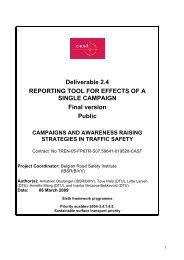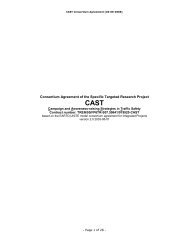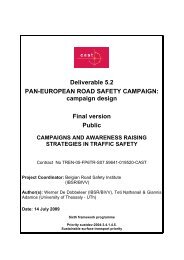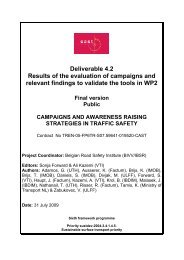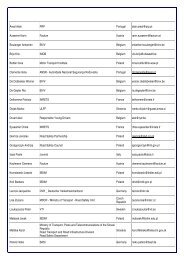Deliverable D 1.3 RESULTS OF META-ANALYSIS ... - cast-eu.org
Deliverable D 1.3 RESULTS OF META-ANALYSIS ... - cast-eu.org
Deliverable D 1.3 RESULTS OF META-ANALYSIS ... - cast-eu.org
You also want an ePaper? Increase the reach of your titles
YUMPU automatically turns print PDFs into web optimized ePapers that Google loves.
Campaigns and awareness raising strategies in traffic safety — <strong>Deliverable</strong> D-1.1One must decide whether to use a so-called fixed-effects or random-effectsmodel when carrying out meta-analysis. A fixed-effects model assumes thatthe same intervention (in our case a road safety campaign) will have the sameeffect regardless of whether it is carried out on different populations, atdifferent times or in different countries. That is, it is assumed that thecharacteristics of the intervention are such that it will have the same effect indifferent contexts. Any variation that is observed will just be due to chance. Arandom-effects model, on the other hand, assumes that characteristics of thesituation, as well as the intervention itself, can cause variations in effect, asindeed can characteristics of the method used to measure the effect.Fortunately again, a statistical test can be used to inform the decision aboutwhich model will give the best estimate of overall effect for a set of effects.The test assesses whether there is significant heterogeneity among the set ofeffects (Everitt, 2002). Non-significant heterogeneity implies homogeneity, inwhich case a fixed-effects model is therefore used to describe the overalleffect. Where the level of heterogeneity is significant, a random-effects modelis used, and an estimator is introduced to account for possible unknownsources of systematic variation between individual effects.The true overall effect of a heterogeneous set of effects can be inaccuratelydescribed using a fixed-effects model, whereas the true overall effect of ahomogeneous set of effects will be estimated quite accurately by both fixedandrandom-effects models. However, because the random-effects modelreports larger confidence intervals, reflecting the greater uncertainty assumed,it is preferable to use a fixed-effects model on a homogenous dataset.Step 4. Conservative best estimate of overall effect.Using the preceding steps it is possible to generate estimates of overall effectin four different ways:(1) using a fixed-effects model without adjusting for publication bias;(2) using a fixed-effects model and adjusting for publication bias;(3) using a random-effects model without adjusting for publication bias;or(4) using a random-effects model and adjusting for publication bias.The statistical output on the level of publication bias and heterogeneity in thedataset is assessed together in order to select the best estimate for anintervention’s overall effect. In this way the statistical tests help answerquestions of generalizability. They address to what extent, based on the set ofeffects identified, one can expect to achieve an overall effect in differentsituations, and therefore what level of confidence should be employed todescribe the overall effect. They essentially allow us to make more usefulpredictions about future situations.The following thus summarizes the strategy followed in the analysis andpresentation of results:(1) always use the random-effects model where heterogeneity isindicated;51



